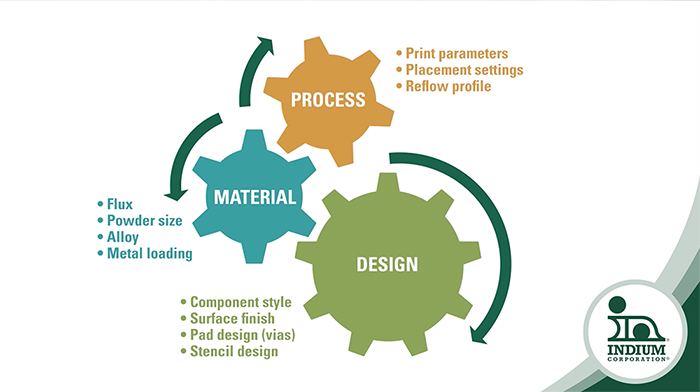Phil Zarrow: Brook, Indium Corporation's been doing some extensive testing on the effect of different process variables on voiding and QFNs. Surface finishes, you've been testing those, can you tell us a little bit about that?
Brook Sandy-Smith: So, our most recent work was with surface finishes, looking at the effect of surface finish on our QFN voiding. When I do material comparisons I always use test boards that have an OSP surface finish because that's the most common surface finish.
Phil Zarrow: Right.
Brook Sandy-Smith: In this case we went back to our circuit board supplier and asked for the same test boards with different surface finishes because that question comes up all the time. "Oh, can I expect the same number if I'm using a different surface finish?" We chose to look at OSP as the benchmark. Then we also testing ENIG and Immersion Silver and Immersion Tin. We also looked at fresh boards versus oxidized boards. The oxidized boards I sent through the reflow oven twice before I added the solder paste and components and refloat it because we all know that surface finishes are there to protect against oxidation with copper.
Phil Zarrow: Right.
Brook Sandy-Smith: If you have oxidation you're not going to get very good solder joints. To simulate that I did the pre-oxidized boards. We actually didn't see very much difference at all between the surface finishes.
Phil Zarrow: That's very surprising because normally common wisdom says that, for example, ENIG, good old gold doesn't oxidize, so I think you would see a marked difference between that and some of the other finishes. We're always worrying about degradation of OSP, and yet you saw virtually no difference.
Brook Sandy-Smith: Very little difference, you're right. With the same material, if I averaged all of the components on all of the test boards then looked at the specific results, the average for each surface finish didn't vary more than about 5% from the average of everything. I didn't see a huge amount of differentiation and you assume that ENIG is going to be the best but that was not what I showed in my study.
Phil Zarrow: Very interesting. This assumes, of course, that the board fabricator has their act together and there's no variances in their process with regard to plating or OSP application, things along those lines. It also assumes that there's compliance with the packaging spec, the IPC-1621, in terms of how the boards are handled and shipped throughout. Assuming all those are done, the surface finishes are done right, you found virtually no difference.
Brook Sandy-Smith: I think that's central to why we didn't have as much variation as we expected due to surface finish because we have these anecdotal feelings about different failures along the way with different surface finishes that may have been influenced by an improperly handled board or an improperly applied surface finish. As long as the boards are stored properly and kept from moisture then the surface finish should have very little effect on your QFN voiding.
Phil Zarrow: Brook, I understand this information is contained in some papers that you've authored.
Brook Sandy-Smith: Right, you can find all of my papers on www.indium.com or if you have any questions or comments you can contact me directly at bsandy@indium.com.
Phil Zarrow: Great, thank you very much.


